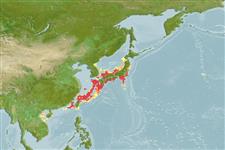Common names from other countries
Lớp phụ Cá sụn (cá mập và cá đuối) (sharks and rays) >
Squaliformes (Sleeper and dogfish sharks) >
Oxynotidae (Rough sharks)
Etymology: Oxynotus: oxys (Gr.), sharp; notos (Gr.), back, referring to its keeled back (“dorso carenato”). (See ETYFish); japonicus: -icus (L.), belonging to: Japan (specifically, Suruga Bay in Honshu), type locality. (See ETYFish).
Environment: milieu / climate zone / depth range / distribution range
Sinh thái học
Biển Tầng đáy biển sâu; Mức độ sâu 150 - 300 m (Ref. 114724). Deep-water
Northwest Pacific: Japan and Taiwan.
Bộ gần gũi / Khối lượng (Trọng lượng) / Age
Maturity: Lm ? range ? - ? cm
Max length : 54.0 cm TL con đực/không giới tính; (Ref. 114724); 64.5 cm TL (female)
Holotype trawled from a depth between 225 and 270 m (Ref. 31258). Ovoviviparous (Ref. 205).
Life cycle and mating behavior
Maturities | Sự tái sinh sản | Spawnings | Egg(s) | Fecundities | Ấu trùng
Distinct pairing with embrace (Ref. 205).
Yano, K. and M. Murofushi, 1985. A new prickly dogfish, Oxynotus japonicus, from Japan. Jap. J. Ichthyol. 32(2):129-136. (Ref. 31258)
IUCN Red List Status (Ref. 130435)
CITES (Ref. 128078)
Not Evaluated
Threat to humans
Harmless
Human uses
Các công cụ
Special reports
Download XML
Các nguồn internet
Estimates based on models
Preferred temperature (Ref.
115969): 1.9 - 16.1, mean 12 (based on 8 cells).
Phylogenetic diversity index (Ref.
82804): PD
50 = 0.5625 [Uniqueness, from 0.5 = low to 2.0 = high].
Bayesian length-weight: a=0.00372 (0.00160 - 0.00860), b=3.15 (2.94 - 3.36), in cm Total Length, based on LWR estimates for this (Sub)family-body shape (Ref.
93245).
Mức dinh dưỡng (Ref.
69278): 3.9 ±0.6 se; based on size and trophs of closest relatives
Thích nghi nhanh (Ref.
120179): thấp, thời gian nhân đôi của chủng quần tối thiểu là 4.5 - 14 năm (Fec assumed to be <100).
Fishing Vulnerability (Ref.
59153): Moderate to high vulnerability (46 of 100).
